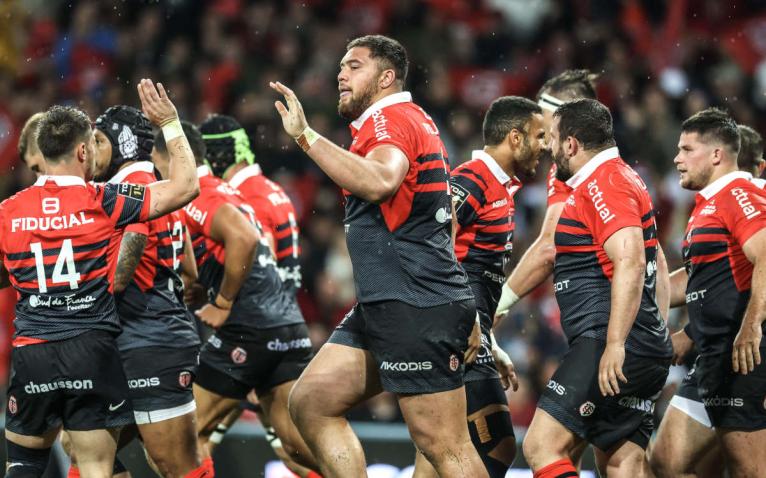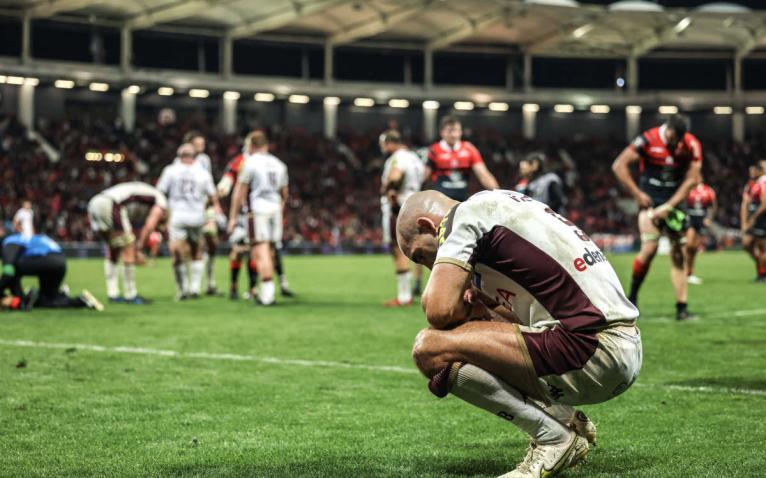French rugby has seen a transformation since 2020 and this writer hadn’t been back for a while to watch rugby so was getting withdrawal symptoms. The solution was easy. A return to witness this metamorphosis in person
But before I take you on my journey to see and feel what I saw, let me remind you of where French rugby had been in the preceding decade.
Back in 2018, I went to see Bertand Pirel, the editor of the prestigious Hugo Sports publishing house in Paris. He was interested in publishing my ode to French rugby, Brothers in Arms, in the run up to the 2019 Rugby World Cup. He had already received a large number of other pitches, but he told me they were all downbeat, negative and reflective of the poor quality of the national side at the time. France hadn’t won the Six Nations since 2010, and in the following decade it regularly hadn’t finished above third place and suffered the ignominy of a last placed finish in 2013.
Bertrand was also very gloomy about French club rugby. In spite of some success in the Champions Cup since 2010, he and many of the former players I interviewed complained about French club rugby’s dominance by non-French qualified players. They felt it had lost its soul and needed rebalancing. Therefore, Bertrand was looking for something nostalgic that reminded the fans of the flair, beauty and romance of French rugby and its native players, developed in the towns and villages around France. My book was in the right place at the right time.

But that was four years ago when French rugby was seemingly in the doldrums. It isn’t anymore. I have spent three weeks visiting Toulouse, La Rochelle and Montpellier, and French club rugby is in rude health on and off the pitch.
You can see this in the Champions Cup. Stade Toulousain won in 2020/21, Stade Rochelais in 2021/2, and Les Rochelais are again in the final next weekend, and in the Six Nations where France were runners up in 2020/21, Grand Slammers in 2021/2 and runners up in 2022/3. Success at club and international level are clearly linked, and France has an array of once-in-a-generation talent spearheaded by Antoine Dupont.
Joe Tekori, the man mountain, was guarding the Stade Toulousain changing room door like a Centurion. Was he there to intimidate? Possibly, but secretly, I think he just wanted to join the other Gladiators on the pitch.
Earlier this month I was in Toulouse to watch Stade Toulousain host Bordeaux-Bègles. Overflowing with a galaxy of stars, it was a match that crackled and fizzed for 80 minutes.
The Stadium de Toulouse was bouncing well before kick-off.
The concourse was packed as the players left the bus. Official photographers snapped away by the players’ entrance as the team buses arrived and the Galacticos made their way into the changing rooms. Some looked relaxed, but most looked nervous as they walked into this sporting colosseum.
Joe Tekori, the man mountain, was guarding the Stade Toulousain changing room door like a Centurion. Was he there to intimidate? Possibly, but secretly, I think he just wanted to join the other Gladiators on the pitch.

Back outside on the concourse, a sea of Toulousain red (with just a smattering of Unionist blue) bobbed and weaved in rhythm and anticipation. The noise was cacophonous already, but nothing compared to what was to come.
These experiences are what life is about. This was the spirit of rugby in all its glory – partisan yes, but without any hint of nastiness. It was fraternal, giving, expressive and free.
As the players ran onto the green velvet, the noise was deafening. The crowd burst into chants, desperate for their team to win. Only the respect for the late Mr Bernard Lapasset seemed to calm everyone down, but not for long.
The crowd exploded again on kick off. Jack Willis caught the ball but Tom was instantly on him with a limpet-like grip. This was no brotherly hug, but a mano-on-mano contest. There was no way his younger sibling could break free. As one, the crowd rose, hissing and cheering in equal measure.
Like Will Skelton, Meafou is very skilful in close quarter contact. Both can jackal, pick and drive in one movement, evade the tackle, and pick clever lines.
Time and again, these two young men scrapped with each other and their opposition. They jackaled, tackled, defended and attacked. The journalist from Bordeaux next to me raved about Tom and his impact on the Bordeaux team since he arrived from Wasps. The Willis bros shone throughout the match, but this battle was far bigger than a family affair.
Let’s start with Manny Meafou, the Samoan-Australian-Frenchman. As the kicking ping pong started, I wondered how the man mountain would preserve his energy on this enormous pitch. He’s a huge man, his socks rolled down like it was the 80th minute, not the 1st.
But looks can be deceptive and I can see why France is courting him so much. Like Will Skelton (another Samoan-Australian), Meafou is very skilful in close quarter contact. Both can jackal, pick and drive in one movement, evade the tackle, and pick clever lines. When Meafou scored recently against Leinster, he picked a brilliant angle against the defensive grain. He punched a hole but still had to get the ball down with his huge hands.

Meafou showed this low-slung power twice before dotting down and France would love to have him among their gargantuan pack later this year.
As well as well power, we saw panache under the Stade Toulousain and French fullback, Thomas Ramos. Running back into his 22m to field a kick, he nonchalantly plucked the ball out of the air behind him. Ramos glides across the field. He moves effortlessly at pace and his running lines are magnificent. A former fly-half, he is a superb footballer and kicker, and knows instinctively when to take measured risks.
Then, there’s Romain Ntamack, a player who seems to have so much time. Sometimes, it appears he is off the pace, but this is merely an illusion. In fact, he is the human embodiment of time dilation. He plays like he can control time, bending it to his will. His capacity to see space and accelerate away or offload deftly under pressure is sublime. Indeed, if he ran on snow, he would leave no trace. For us French rugby romantics, he can excite us as much as his celestial half-back partner, Antoine Dupont.
Accelerating at interstellar speed, Dupont streaked away from four defenders, hurdling over the last one, the young Bielle-Biarrey, before sliding over the try line. It was a jaw-dropping moment.
Dupont’s skills were visible from the start, but he made the crowd wait half an hour before we saw his unique pyrotechnics. Breaking left then right, he accelerated through the gap making some 20 metres before the excellent Lucu and Moefana brought him down. But the damn had burst and the giant Roumat scored in the corner.
Just before the break, Dupont switched and gave the ball to Arthur Retière, the diminutive winger, who burst through, tackled again by Maxime Luku. After a few phases, Dupont scanned and broke left. In spite of Bordeaux’s defence, he created the overlap for Jack Willis to score in the corner. Was it all down to Dupont’s talent? Not quite. His heavy lifters, the brilliant Dorian Aldegheri and Cyril Baille, ran straight lines, fixing the opposition. Dupont’s talent is clear, but so too is Stade Toulousain’s cohesion and collective mastery.
We had to wait a full hour before we witnessed the pièce de resistance. From a slickly-worked line out on the 40m line, Peato Mauvaka peeled around to the open side. Taking the ball from the replacement Rodrigue Neti, he fed Dupont on the switch who burst through the gap. Accelerating at interstellar speed, he streaked away from four defenders, hurdling over the last one, the young Bielle-Biarrey, before sliding over the try line. It was a jaw-dropping moment.
Dupont was happy too, kicking the ball high into the stand in celebration, in a rare show of emotion.

Dupont could play anywhere in the backs, but he is best in the middle controlling the tempo, scanning for space and using his speed to sprint into the gaps. He can blaze a trail with his snipes, deliver bone-crunching tackles, run brilliant support lines, deliver fizzing passes off both hands, reverse or deft passes and kick long distances, all with seeming ambidexterity. The French team’s spine is built around him – Marchand, Alldritt, Ntamack, Danty, Ramos – and it is a frightening prospect for defences to counter, and why there are such high hopes for a first World Cup trophy in October.
On this night, Stade Toulousain emerged victorious over Bordeaux-Begles.
Out of a cacophony of notes and noise, great conductors are able to see and create a symphony of meaning and order. Dupont is like this on the rugby pitch. From an assemblage of bodies in perpetual motion, he can sense and see space better than other player on the planet, his virtual radar guiding him with precision. Right now, his supremacy is unrivalled.
If this is what most Top 14 matches are like, rugby fans will be emigrating soon and seeking a French passport. Rugby spectacles like this transcend every partisan emotion, so Pelé was wrong, rugby is the beautiful game.



Great article and why the top 14 is such an attraction just now. Brothers in arms is a fabulous read of the previous golden era of French rugby!
It's Bertrand, but ok.
Excellent article Dave. A real insight.